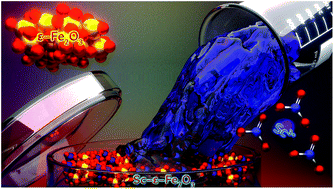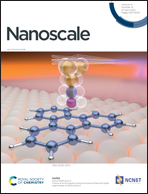An effect of scandium substitution on the phase purity and structural, magnetic, and electrochemical features of ε-Fe2O3 nanoparticle systems
Abstract
A series of Sc-substituted ε-Fe2O3 nanoparticles embedded in a silica matrix were synthesized by a sol–gel process. It was found that the preparation of a pure ε-Fe2O3 phase without any other iron(III) oxide phases as admixtures was achieved for ε-Sc0.1Fe1.9O3 (5 at% of Sc) as documented by analyses of X-ray powder diffraction (XRD) results. Extensive physicochemical characterization of the ε-Sc0.1Fe1.9O3 sample was performed employing transmission electron microscopy (TEM), high-resolution transmission electron microscopy (HRTEM), magnetization measurements, 57Fe Mössbauer spectroscopy, and electrochemical impedance spectroscopy (EIS). Magnetization vs. temperature plots showed vanishing of the two-step magnetic transition for the Sc-doped ε-Fe2O3 sample; a decrease in the magnetization profile was observed only once upon the change in the temperature. The Sc3+ substitution was found to cause a constriction of the magnetic transition region and a shift of the onset of the magnetic transition to a higher temperature in comparison with the undoped ε-Fe2O3 system. Moreover, upon the introduction of Sc3+ ions in the ε-Fe2O3 crystal lattice, a magnetic hardness was altered accompanied by a decrease in the coercivity. With 57Fe Mössbauer spectroscopy, it was identified that Sc3+ predominantly substitutes Fe3+ in the distorted octahedral A- and B-sites and with almost equivalent occupation probability at both positions. Moreover, the electrochemical measurements confirmed the increase in the resistivity in the Sc-doped ε-Fe2O3 systems. Thus, the results, achieved within the present study, demonstrated an effect of Sc3+ substitution on the preparation purity of ε-Fe2O3 systems without the presence of any other iron(III) oxide admixtures and on the change in its magnetic and electrochemical features, proving their feasible tuning with respect to the requirements of potential future applications.



 Please wait while we load your content...
Please wait while we load your content...